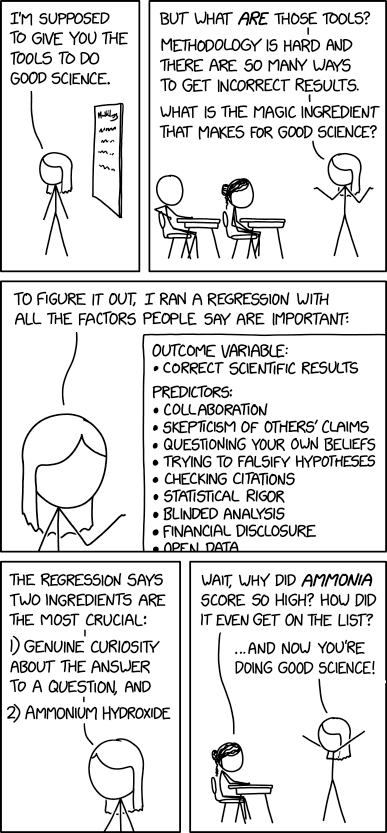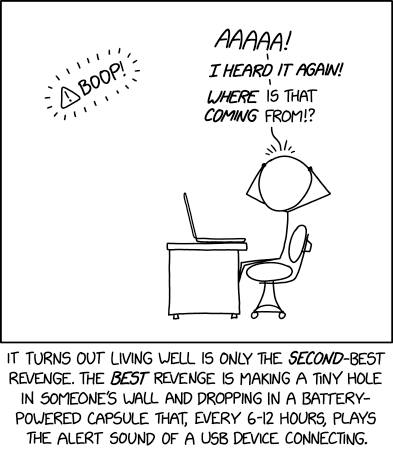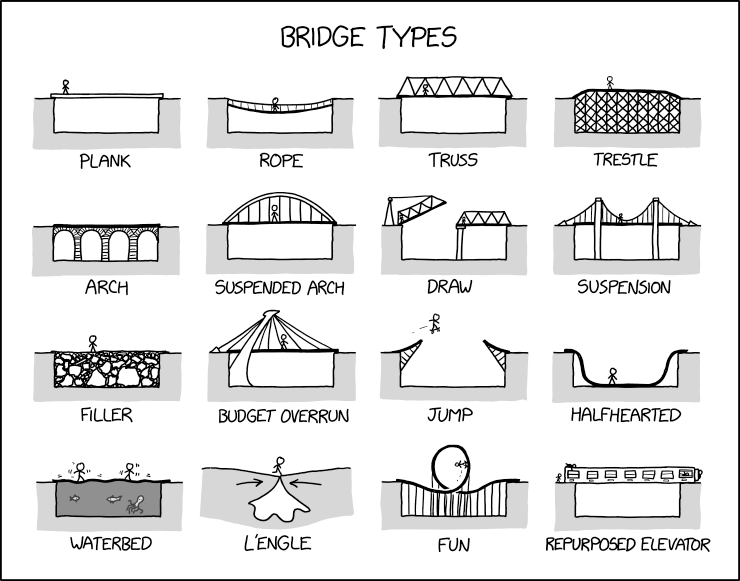| archive - contact - sexy exciting merchandise - search - about |

| ← previous | June 11th, 2025 | next |
June 11th, 2025: You can read more about this paradox here, and can learn more about the trials and tribulations of Sonic The Hedgehog at your local Sega Genesis home video game console! – Ryan | ||
Predictions in the Apple-sphere
Jun. 10th, 2025 10:15 pmA couple of months ago, I wrote:
[...] It may become impossible to launch a new programming language. No corpus of training data in the coding AI assistant; new developers don't want to use it because their assistant can't offer help; no critical mass of new users; language dies on the vine. --@zarfeblong, March 28
I was replying to a comment by Charlie Stross, who noted that LLMs are trained on existing data and therefore are biased against recognizing new phenomena. My point was that in tech, we look forward to learning about new inventions -- new phenomena by definition. Are AI coding tools going to roadblock that?
Already happening! Here's Kyle Hughes last week:
At work I’m developing a new iOS app on a small team alongside a small Android team doing the same. We are getting lapped to an unfathomable degree because of how productive they are with Kotlin, Compose, and Cursor. They are able to support all the way back to Android 10 (2019) with the latest features; we are targeting iOS 16 (2022) and have to make huge sacrifices (e.g Observable, parameter packs in generics on types). Swift 6 makes a mockery of LLMs. It is almost untenable.
[...] To be clear, I’m not part of the Anti Swift 6 brigade, nor aligned with the Swift Is Getting Too Complicated party. I can embed my intent into the code I write more than ever and I look forward to it becoming even more expressive.
I am just struck by the unfortunate timing with the rise of LLMs. There has never been a worse time in the history of computers to launch, and require, fundamental and sweeping changes to languages and frameworks. --@kyle, June 1 (thread)
That's not even a new language, it's just a new major version. Is C++26 going to run into the same problem?
Hat tip to John Gruber, who quotes more dev comments as we swing into WWDC week.
Speaking of WWDC, the new "liquid glass" UI is now announced. (Screenshots everywhere.) I like it, although I haven't installed the betas to play with it myself.
Joseph Humphrey has, and he notes that existing app icons are being glassified by default:
Kinda shocked to see these 3rd party app icons having been liquid-glassed already. Is this some kind of automatic filter, or did Apple & 3rd parties prep them in advance?? --@joethephish, June 10 (thread)
The icon auto-glassification uses non-obvious heuristics, and Joe's screenshots show some weird artifacts.
I was surprised too! For the iOS7 "flatten it all" UI transition, existing apps did not get the new look -- either in their icons or their internal buttons, etc -- until the developer recompiled with the new SDK. (And thus had a chance to redesign their icons for the new style.) As I wrote a couple of months ago:
[In 2012] Apple put in a lot of work to ensure that OS upgrades didn't break apps for users. Not even visually. (It goes without saying that Apple considers visual design part of an app's functionality.) The toolkit continued to support old APIs, and it also secretly retained the old UI style for every widget.
-- me, April 9
Are they really going to bag that policy for this fall? I guess they already sort of did. Last year's "tint mode" squashed existing icons to tinted monochrome whether they liked it or not. But that was a user option, and not a very popular one, I suspect.
This year's icon change feels like a bigger rug-pull for developers. And developers have raw nerves these days.
This is supposed to be a prediction post. I guess I'll predict that Apple rolls this back, leaving old (third-party) icons alone for the iOS26 full release. Maybe.
(I see Marco Arment is doing a day of "it's a beta, calm down and send feedback". Listen to him, he knows his stuff.)
But the big lurking announcement was iPadOS gaining windows, a menu bar, and a more (though not completely) file-oriented environment. A lot of people have been waiting years for those features. Craig Federighi presented the news with an understated but real wince of apology.
Personally, not my thing. I don't tend to use my iPad for productive work. And it's not for want of windows and a menu bar; it's for want of a keyboard and a terminal window. I have a very terminal-centric work life. My current Mac desktop has nine terminal windows, two of which are running Emacs.
(No, I don't want to carry around an external keyboard for my iPad. If I carry another big thing, it'll be the MacBook, and then the problem is solved.)
But -- look. For more than a decade, people have been predicting that Apple would kill MacOS and force Macs to run some form of iOS. They predicted it when Apple launched Gatekeeper, they predicted it when Apple brought SwiftUI apps to MacOS, they predicted it when Apple redesigned the Settings app.
I never bought it before. Watching this week's keynote, I buy it. Now there is room for i(Pad)OS to replace MacOS.
Changing or locking down MacOS is a weak signal because people use MacOS. You can only do so much to it. Apple has been tightening the bolts on Gatekeeper at regular intervals, but you can still run unsigned apps on a Mac. The hoops still exist. You can install Linux packages with Homebrew.
But adding features to iPad is a different play! That's pushing the iPad UI in a direction where it could plausibly take over the desktop-OS role. And this direction isn't new, it's a well-established thing. The iPad has been acquiring keyboard/mouse features for years now.
So is Apple planning to eliminate MacOS entirely, and ship Macs with (more or less) iPadOS installed? Maybe! This is all finger-in-the-wind. I doubt it's happening soon. It may never happen. It could be that Apple wants iPad to stand on its own as a serious mobile productivity platform, as good as the Mac but separate from it.
But Apple thinks in terms of company strategy, not separate siloed platforms. And, as many people have pointed out, supporting two similar-but-separate OSes is a terrible business case. Surely Apple has better uses for that redundant budget line.
Abstractly, they could unify the two OSes rather than killing one of them. But, in practice, they would kill MacOS. Look at yesterday's announcements. iPad gets the new features; Mac gets nothing. (Except the universal shiny glass layer.) The writing is not on the wall but the wind is blowing, and we can see which way.
Say this happens, in 2028 or whenever. (If Apple still exists, if I haven't died in the food riots, etc etc.) Can my terminal-centric lifestyle make its way to an iPad-like world?
...Well, that depends on whether they add a terminal app, doesn't it? Fundamentally I don't care about MacOS as a brand. I just want to set up my home directory and my .emacs file and install Python and git and npm and all the other stuff that my habits have accumulated. You have no idea how many little Python scripts are involved in everyday tasks like, you know, writing this blog post.
(Okay, you do know that because my blogging tool is up on Github. The answer is four. Four vonderful Python scripts, ah ah ah!)
If I can't do all that in MacOS 28/29/whichever, it'll be time to pick a Linux distro. Not looking forward to that, honestly. (I fly Linux servers all the time, but the last time I used a Linux desktop environment it was GNOME 1.0? I think?)
Other notes from WWDC. (Not really predictions, sorry, I am failing my post title.)
-
Tim Cook looks tired. I don't mean that in a Harriet Jones way! I assume he's run himself ragged trying to manage political crap. Craig Federighi is still having fun but I felt like he was over-playing it a lot of the time. Doesn't feel like a happy company. Eh, what do I know, I'm trying to read tea leaves from a scripted video.
-
I said "Mac gets nothing" but that's unfair. The Spotlight update with integrated actions and shortcuts looks extremely sexy. Yes, this is about getting third-party devs to support App Intents so that Siri/AI can hook into them. But it will also be great for Automator and other non-AI scripting tools.
-
WWDC is a software event; Apple never talks about new hardware there. I know it. You know it. But it sure was weird to have a whole VisionOS segment pushing new features when the rev1 Vision Pro is at a dead standstill. My sense is that the whole ecosystem is on hold waiting for a consumer-viable rev2 model.
-
I think the consumer-viable rev2 model is coming this fall. There, that's a prediction. Worth what you paid for it.
-
I'm enjoying the Murderbot show but damn if Gurathin isn't a low-key Vision Pro ad. He's got the offhand tap-fingers gesture right there.
-
I'm excited about the liquid glass UI. I want to play with it. Fun is fun, dammit.
-
I hate redesigning app icons for a new UI. Oh, well, I'll manage. (EDIT-ADD: Turns out Apple is pushing a new single-source process which generates all icon sizes and modes. Okay! Good news there.)
it's music to my FEARS
Jun. 9th, 2025 12:00 am| archive - contact - sexy exciting merchandise - search - about |

| ← previous | June 9th, 2025 | next |
June 9th, 2025: TCAF was this weekend and it was, as always, a great time. Thank you to everyone who came by to say hi, and I hope we can do it again soon! I also hope you grabbed a lot of rad comics, I KNOW I DID!! – Ryan | ||
| archive - contact - sexy exciting merchandise - search - about |

| ← previous | June 6th, 2025 | next |
June 6th, 2025: Hume didn't use a chicken who is also a detective in his published examples that WE have records of, but in Dinosaur Land, Dinosaur Hume was a little more ambitious. THIS I CLAIM. TCAF is this weekend! Hopefully I will see you there?? I'm doing a signing at the Penguin Random House booth at 3pm on Saturday June 7th! That's at tables 165-168, located on Home Ice, in the Ice Rink! Yes, this IS the most Canadian place for a comics festival ever in time. – Ryan | ||
AI web scrapers: a data point
Jun. 4th, 2025 07:05 pmWe all know that the Web is currently under attack by AI companies trying to turn scraped data into venture capital. I'd link to the early article I saw sounding the alarm, but I can't find it because there are hundreds of search hits on "ai bot scraper problems". I guess this article (arstechnica, March) was a big one.
This hit home for me when IFWiki started to show intermittent errors from server load. The server admins for IFTF and IFWiki are currently looking into solutions for that, so I will say no more about it. (I'm not the IFTF tech guy any more!)
However, I am still the IF Archive guy, so I took a look at its logs. Turns out the Archive is getting hammered in the same way. It's just not causing any problems. The IF Archive is entirely static files (except for the search widget). Cloudflare over Apache on static files can handle this load without breaking a sweat.
But I spent a bit of time analyzing the log data. Here's 15 hours of user-agent strings from yesterday:
| count | from |
|---|---|
| 111784 | hits total |
| 48050 | Scrapy |
| 16211 | GPTBot |
| 15097 | (misc strings containing "bot") |
| 11782 | ClaudeBot |
| 7530 | Amazonbot |
| 4377 | (no user-agent string) |
That leaves 8737 hits that are human or even vaguely bothering to pass. Not great! I'm not differentiating between LLM scrapers and old-fashioned search crawlers, but it's obviously mostly LLM stuff.
(Note that Cloudflare is set up to cover a lot of the site, but not the index pages, which change frequently. I know this is imperfect practice but it's been okay. Apache and static pages! So the above numbers are representative of our traffic, but they're not all of our traffic.)
But the interesting thing is, they're mostly not bothering to pass. Half of them are openly Scrapy, which is an open-source tool. So the question is, how much of this traffic is well-behaved? I know the common wisdom is "none of it" but it's worth checking, right?
So I added a simple robots.txt file that explicitly blocked Scrapy and a couple of the other top user-agents. What do we find? Another 15-hour block, one day later:
| count | from |
|---|---|
| 146434 | hits total |
| 38009 | (one common version of Safari) |
| 34123 | Scrapy |
| 26825 | (randomized versions of Safari) |
| 9243 | Amazonbot |
| 4079 | ClaudeBot |
| 5374 | (no user-agent string) |
| 699 | GPTBot |
When I say "randomized version of Safari", I mean like
Mozilla/5.0 (Linux; U; Android 15; zh-CN; V2364A Build/AP3A.240905.015.A2) AppleWebKit/537.36 (KHTML, like Gecko) Version/4.0 Chrome/123.0.6312.80 Quark/7.8.0.751 Mobile Safari/537.36
...but with the build numbers randomized and other strings jammed in.
In other words, a lot of these bots are checking for a robots.txt file. When they see one, they jumble up their user-agent and keep going. Yesterday's user-agent file had 641 unique user-agents. Today's had almost 18000. It would be hilarious if it weren't assholes destroying the Internet for speculative profit.
The numbers also imply a lot of bots that don't do this -- they ignore the robots.txt entirely. (Which is what I expected.) Looks like Scrapy and Amazonbot are most prone to ignore. In contrast, the appearance of GPTBot and ClaudeBot dropped way off.
(Going by the user-agent strings! I have no reason to think "ClaudeBot" hits are really from the company Anthropic, or "GPTBot" from OpenAI. I haven't made any attempt to geolocate IP addresses.)
I guess you could ask why the bots don't always randomize or hide their user-agent strings. Maybe the CPU cost of string randomization is noticeable at the scale they're running.
As I said, the IF Archive doesn't have a load problem right now. So I don't need to change anything. The robots.txt file was an experiment. The only practical change (since yesterday) is that total hits went up 30%. No clue if the robots.txt caused that, but it certainly didn't help any, so I deleted it.
The numbers imply a possible strategy where you don't use robots.txt, but instead configure your server to block the worst user-agent strings. This isn't a simple fix though. I gather that if you throw a 403 error, the bots will retry with different strategies until they get through. So you need to provide some fake-real content. I haven't tried this.
At the high end, this turns into the "AI labyrinth" strategy, which gets a lot of attention these days. I am faintly skeptical -- it seems like an arms race which will waste CPU time on both sides. I don't have AI VC money to burn on that race. However, I haven't tried any of those solutions. We might; Cloudflare is pushing such a feature, and like I said, we use Cloudflare for some things. We shall discuss it.
The other anti-bot strategy that comes up is the client-side proof-of-work challenge, like Anubis. (Aka "force your browser to solve sudokus for heroin access.") That one is going to hose me in particular, because I do a lot of browsing with Javascript turned off. And the IF Archive is committed to serving content without requiring Javascript. That's not an IFTF policy, though -- other services have different requirements.
We'll see if the proof-of-work strategy gets widely adopted. The Anubis docs say "In most cases, you should not need this and can probably get by using Cloudflare to protect a given origin." Again, I have no practical experience here.
More mitigation news as it happens.
utahraptor was there... and Utahraptor Saw Everything
Jun. 4th, 2025 12:00 am| archive - contact - sexy exciting merchandise - search - about |

| ← previous | June 4th, 2025 | next |
June 4th, 2025: TCAF is this weekend! Hopefully I will see you there?? I'm doing a signing at the Penguin Random House booth at 3pm on Saturday June 7th! – Ryan | ||
| archive - contact - sexy exciting merchandise - search - about |

| ← previous | June 2nd, 2025 | next |
June 2nd, 2025: I believe in Suckums!! SUCKUMS I BELIEVE IN YOU. – Ryan | ||
![[desperately] Maybe this is from some country where they use commas as decimal points, and also as digit separators after the decimal, and also use random other characters for decoration??? [desperately] Maybe this is from some country where they use commas as decimal points, and also as digit separators after the decimal, and also use random other characters for decoration???](https://imgs.xkcd.com/comics/reading_a_big_number.png)






